
Jongejan, FransĪ novel Babesia species, designated Babesia bicornis sp. nov.: Tick-Borne Parasites Associated with Mortality in the Black Rhinoceros ( Diceros bicornis)

Grasses comprised 4.5%īabesia bicornis sp. Results of backtracking showed that the rhinos browsed on 80 plant species. Both methods yielded different results, with a large bias for dominant species. The diet of black rhinoceros ( Diceros bicornis minor) was studied using backtracking and faecal analysis in South Africa. Eastern black rhinoceros ( Diceros bicornis michaeli) epitomise theĪ comparison of faecal analysis with backtracking to determine the diet composition and species preference of the black rhinoceros ( Diceros bicornis minor)

For such populations to act as vital reserves, they must be viable and sustainable. Shultz, S.Įx situ populations play a critical role for the conservation of endangered species, especially where in situ populations face imminent threats. Low birth rates and reproductive skew limit the viability of Europe’s captive eastern black rhinoceros, Diceros bicornis michaeliĮdwards, K.L. bothae population are both conservation priorities of the reserve.

Maintaining the endangered black rhinoceros and the protected E. In the Great Fish River Reserve, South Africa, black rhinoceros ( Diceros bicornis minor) feed extensively on a local population of Euphorbia bothae. Impact of black rhinoceros ( Diceros bicornis minor) on a local population of Euphorbia bothae in the Great Fish River Reserve, South Africa


 0 kommentar(er)
0 kommentar(er)
